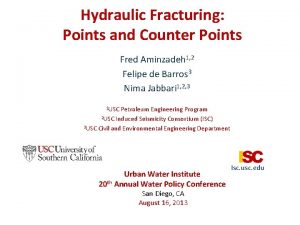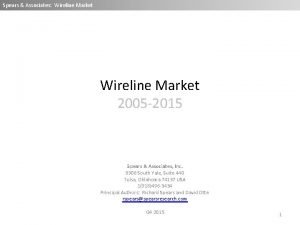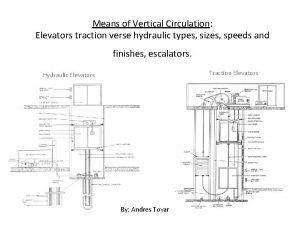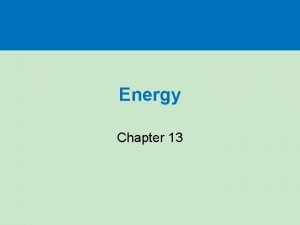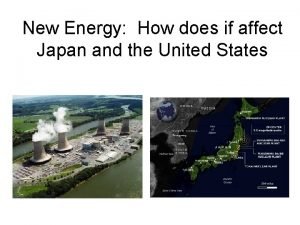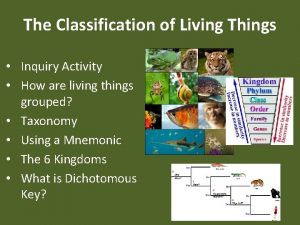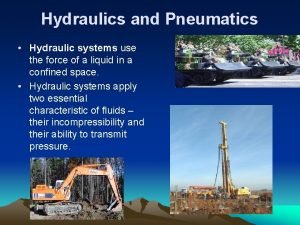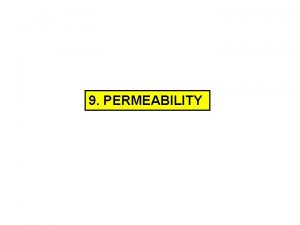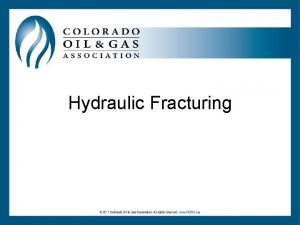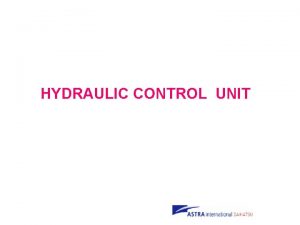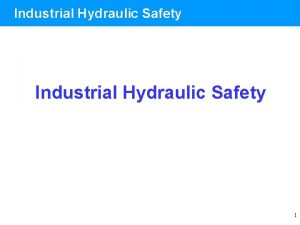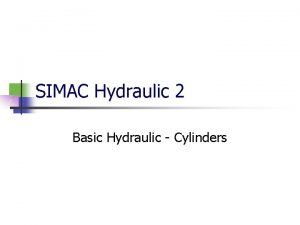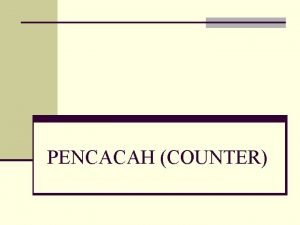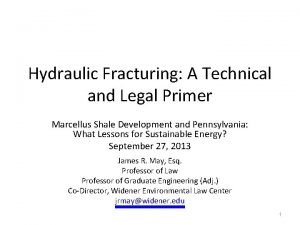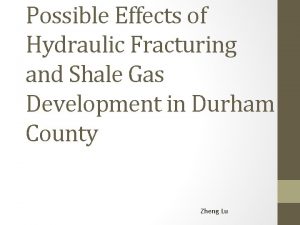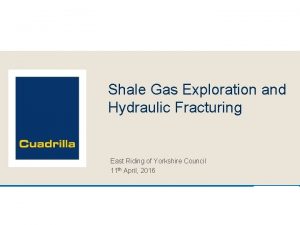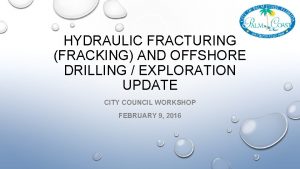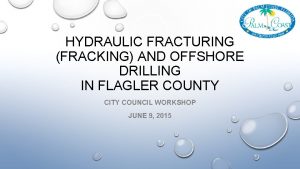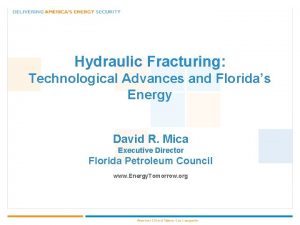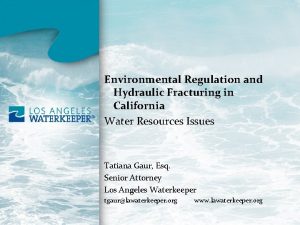Hydraulic Fracturing Points and Counter Points Fred Aminzadeh

















- Slides: 17

Hydraulic Fracturing: Points and Counter Points Fred Aminzadeh 1, 2 Felipe de Barros 3 Nima Jabbari 1, 2, 3 1 USC Petroleum Engineering Program 2 USC Induced Seismicity Consortium (ISC) 3 USC Civil and Environmental Engineering Department Urban Water Institute 20 th Annual Water Policy Conference San Diego, CA August 16, 2013 Isc. usc. edu

Summary Ø What is Hydraulic Fracturing (Fracking) Ø Fracking Risk Factors Ø Induced Seismicity Ø Monterey shale Ø Balance

Fracking: Overview Ø Natural gas: good alternative for fossil fuels (less CO 2 production) Ø Shale Formation, low permeability, rich of natural gas (known as Shale Gas) Ø Unconventional vs. Conventional Ø The Potential Gas Committee: within five years the potential reserves of shale gas has tripled from 200 trillion cubic feet in 2006 to nearly 700 trillion cubic feet in 2010 Ø Tight formation => Stimulation Methods to change the permeability Shale plays in the USA (EIA) (Hydraulic Fracturing)

What is Fracking Ø Hydraulic fracturing is stimulating rock layers by a pressurized liquid to facilitate release of gas and oil. Ø It creates fractures from a wellbore drilled into reservoir http: //en. wikipedia. org/wiki/Hydraulic_fracturing

More on Fracking Hydraulic Fracturing

Why worry? ü HF fluid = water and various chemical additives. q 750 chemicals (toxic) in the HF fluids q The choice of the chemicals and quantities vary according to site conditions & project needs q Commonly used chemicals: Ø HF fluid: methanol, isopropanol, quartz, ethylene glycol monobutyl ether, ethylene glycol, light petroleum distillates and sodium hydroxide ü Recovered HF fluids contaminated when in contact with the shale. ü Accidental spill of the HF fluid (prior to injection or recovered)

More on Potential Risk Factors Ø Contamination of ground water Ø Depletion of fresh water (Recovered fluid: 25 -100 %) Ø Risks to air quality (CH 4, VOC’s) Ø Migration of gases and chemicals to the surface Ø Surface contamination from spills and flow-back Ø Induced Seismicity

3000 -8000 ft Examples of Risk Pathways: Groundwater Contamination Figure 3. Schematic illustration of the conceptualization associated with S 2, showing multiple contaminant pathways stemming from the subsurface. The HF fluid and other contaminants can travel toward groundwater aquifer through failed well casing (A), fractures (B), and faults (C). Rupture in the well! Contamination of the aquifer. Figure 2. Conceptual illustration for surface to aquifer contamination pathway (items 1 and 3). Spill in the ground surface! Contamination of the vadose zone and eventually the aquifer.

Contamination from Recovered HF Fluid Ø Recovered HF fluids may become contaminated once they are in contact with the shale. Ø HF fluids extract heavy metals, hydrocarbons, natural salts and radioactive materials from the shale. Ø Recovered HF fluids may contain the following chemicals: chloride, sodium, bromide, arsenic, barium and natural occurring radioactive materials (NORM) such as uranium, radon and radium [Rozell and Reaven, 2012] as well as high TDS values (70, 000 to 250, 000 mg/L) [NETL, 2013] Any accidental spill related to the HF fluid (prior to injection or recovered) can pose risk to aquifers and human health (many of these chemicals are carcinogenic)

Introduction to Induced Seismicity fracture treatment / Fluid Injection / CCS Increase in stress and pore Pressure Decrease the stability of existing weak planes (natural fractures, bedding planes) slip and fail, similar to earthquakes along faults slippages emit elastic waves (stimulated seismicity) Induced Seismicity Data Base Models-IS Risk Maps

Preliminary Observations on Induced Seismicity Ø The energy level which is released is large enough to be recorded, but too low to directly create major seismic events, Ø Real time monitoring of Micro-earthquake data can help mitigate or reduce the risk of triggering large damaging earthquakes, Ø We are looking into three test beds: San Joaquin Valley, CA, Youngstown, Ohio and Blackpool, UK, Ø Similar to the “Earthquake Hazard Maps”, IS hazard maps can alleviate the concerns for IS risk of SFIP in the majority of cases, Ø More modeling, statistical analysis and research needed to substantiate some of the preliminary conclusions.

California Monterey Shale Ø (EIA) estimates the Monterey/Santos play holds 15. 4 bbo of shale resources; the Bakken and Eagle Ford combined have about 7 bbo Ø The Monterey shale is the primary source rock for the conventional oil reservoirs found in the Santa Maria and San Joaquin basins in southern California play full of complexities Monterey Shale Continues to Tempt and Tease www. aapg. org/explorer/2013/02 feb/monterey_shale 0213. cfm http: //www. aapg. org/explorer/2012/11 nov/monterey 11 12. cfm

Monterey Shale Development, Pros and Cons Benefits: Ø Ø Create more jobs: 512 K to 2. 8 million new jobs Stimulate economy. GDP up by 2. 6 -14. 3% Increase personal income. Up by 2. 1 -10. 0% Boost State revenue. Tax growth $4. 5 -24. 6 B Caveats: Ø Ø Exploratory study and preliminary results Warrants further multi-dimensional studies Need to examine: environmental issues, Need to address technology challenges http: //gen. usc. edu/assets/001/84954. pdf

Should Fracking Stop? A drilling operation in Bradford County, PA: Extracting gas from shale increases the availability of this resource, but the health and environmental risks may be too high. POINT COUNTERPOINT Say Robert W. Howarth and Anthony Ingraffea. says Terry Engelder. Yes, it’s too high risk Natural gas extracted from shale comes at too great a cost to the environment, No, it’s too valuable Fracking is crucial to global economic stability; the economic benefits outweigh the environmental risks, http: //www. nature. com/nature/journal/v 477/n 7364/full/477271 a. html

Concerns to Address Ø Ø Ø Balance Water supply contamination Increased induced seismicity Land-use challenges Water-use challenge Potential to overwhelm community infrastructure Continued reliance on fossil oil Possible Steps Ø Ø Ø More Science More Disclosure Understand economic impacts of extreme measures Improve Education/Outreach Listen to both sides To Frack or not to Frack, That is the Question Science is the Answer: Vincit Veritas (Truth Prevails)

Summary Ø What is Hydraulic Fracturing (Fracking) Ø Fracking Risk Factors Ø Induced Seismicity Ø Shale Resources and the Role of Fracking in their Development Ø Monterrey shale and its potential economic impacts in California Ø Technology requirements for Monterrey shale development Ø Where do we go from here

Thanks!
 Fred aminzadeh
Fred aminzadeh Spears and associates hydraulic fracturing market report
Spears and associates hydraulic fracturing market report Types of vertical circulation
Types of vertical circulation Hydraulic fracturing disadvantages
Hydraulic fracturing disadvantages Hydraulic fracturing webquest
Hydraulic fracturing webquest Brand positioning bulls eye
Brand positioning bulls eye Point of difference and point of parity
Point of difference and point of parity Transforming and combining random variables
Transforming and combining random variables The value disciplines model
The value disciplines model Michael treacy and fred wiersema
Michael treacy and fred wiersema Waterfall strategy marketing
Waterfall strategy marketing The guy who sits behind marsha likes to play the drums
The guy who sits behind marsha likes to play the drums King philip coughed on fred
King philip coughed on fred Taxonomy is the branch of science that deals with –
Taxonomy is the branch of science that deals with – Assumption of darcy law
Assumption of darcy law Hydraulics and pneumatics basics
Hydraulics and pneumatics basics Difference between permeability and hydraulic conductivity
Difference between permeability and hydraulic conductivity Hydrologic continuity equation
Hydrologic continuity equation
